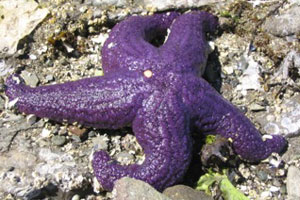Sea Star

A purple Ochre Star.
When to go:
Any time of year, but the best low tides are in the spring and summer.
Where to go:
What to look for:
Sea stars are intertidal animals, meaning they live in the area that is affected by the tides. They need water to breathe and move, but their food is sometimes out of the water, so they are fairly tolerant of getting left high and dry for a while.
Sea stars eat in a rather fascinating way. Many are predators, eating clams and other hard-shelled molluscs. To open the shell, the sea star wraps around the clam and pulls. The clam never wins this fight, because the sea star actually relaxes to pull on the shell! It's just the way their tube feet work.
When the sea star gets the clam open, it throws up its own stomach into the clam's shell. The star digests the clam right where it is, and then sucks its stomach back into its body. Amazing!
-
Ochre or Purple Star
 Like most sea stars, Ochre stars are very slow movers. They eat mussels and barnacles.
Like most sea stars, Ochre stars are very slow movers. They eat mussels and barnacles.
Ochre stars are very common in the Salish Sea. They are also called Purple stars, since many of them are a truly spectacular shade of purple. However, they can be orange, yellow, brown, or any shade in between. They are never pink, which can be useful for identifying them.
-
Sunflower Star
 The Sunflower star is the cheetah of sea stars: they can move 3 feet every minute. They are also quite large, and can be 3 feet across. They eat sea urchins and clams, and sometimes even other sea stars. They often climb into crab pots to eat the bait.
The Sunflower star is the cheetah of sea stars: they can move 3 feet every minute. They are also quite large, and can be 3 feet across. They eat sea urchins and clams, and sometimes even other sea stars. They often climb into crab pots to eat the bait.Unlike many other sea stars, Sunflower stars have many arms, sometimes as many as 25! They are also very soft to the touch, so if you find one within reach, be very gentle, and never, ever touch their delicate tube feet.
It's not a fish, so what is it?
Sea stars are echinoderms, which means they usually have 5-point radial symmetry. That's a fancy way of saying they look like a star or a pentagram. Sea urchins, sand dollars and sea cucumbers are also echinoderms, and are closely related to sea stars.
Many sea stars are carnivores - they eat clams, mussels, oysters, sand dollars and anything else they can catch. Many other sea stars are scavengers.
If you find a sea star stranded on a sandy part of the beach, you can gently pick it up and place it back in the water - but don't touch the underside! It can't hurt you, but you might hurt it. Sea stars have thousands of tube feet, and they are very delicate. If a star latches on to you, wait for it to let go. If you pull away, you'll tear its feet off.
Don't try to pick up a sea star that is attached to a rock. It's happy where it is, even if it's out of the water. The tide will come back, and the star will be fine.
Sources:
PTMSC, 2012
Images by USFWS, Molly Kent
